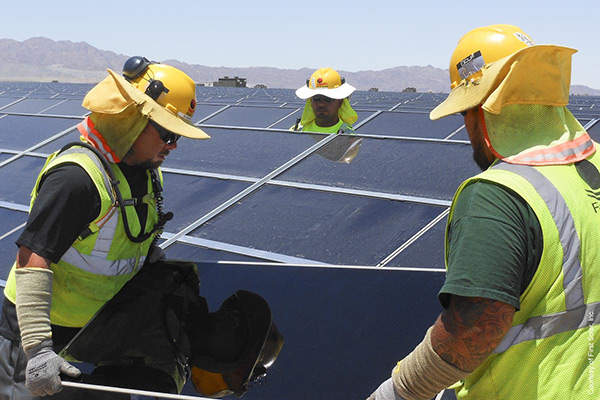Desert Sunlight Solar Farm is a 550MW photovoltaic (PV) solar power project built across 3,600 acres of land in the Chuckwalla Valley, California, US.
It was developed by NextEra Energy Resources and GE Financial Services and is located in Riverside County on land managed by the US Bureau of Land Management (BLM).
The project witnessed the start of construction in September 2011 and was commissioned in February 2015.
It is capable of generating enough clean energy to serve around 160,000 California homes and displaces 300,000mt of carbon dioxide emissions annually. It is expected to support the state in achieving 33% of power from renewable resources by 2020.
Pacific Gas & Electric (PG&E) purchases the power generated in the first phase while Southern California Edison purchases the power generated in the second phase, under two separate long-term power purchase agreements (PPA).
Solar farm composition and development phases
The transmission infrastructure is built across 230 acres and the new Red Bluff substation is built on a 90-acre site. The substation is owned and operated by Southern California Edison.
The solar farm employs approximately 8.8 million cadmium telluride thin-film PV modules. The PV modules are installed at less than 6ft in height above the ground, causing low visual impact. The project uses around 70,000t of American steel.
The solar farm project was developed in two phases. The first phase has an installed capacity of 300MW, while the second phase has 250MW, adding up to a total generating capacity of 550MW.
Construction approval and EPC contract
The project got final approval from the Department of Interior Secretary Ken Salazar in August 2011 and construction was started immediately.
First Solar was awarded an engineering, procurement and construction (EPC) contract for the construction of the Desert Sunlight solar project.
Under the EPC contract, First Solar provided the thin-film PV modules and EPC services. The company will operate and maintain the solar farm for 25 years under a separate agreement.
First Solar manufactured the PV modules at its Mesa facility. The overall contract execution required approximately 440 construction workers.
Desert Sunlight project network connection
The Desert Sunlight solar farm is connected to the Red Bluff Substation by a 230kV interconnection transmission line. The Red Bluff substation supplies the output power to the national grid through Southern California Edison’s Devers-Palo Verde 1 transmission line.
The US Department of Energy approved $1.88bn in partial loan guarantees for the project in September 2011.
Local environmental impact in Riverside County
The Interior’s BLM, along with the National Park Services and stakeholders, closely observed the project in order to reduce the proposed land used for the solar farm. The project was environmentally analysed and reviewed. The final environmental review report was released on 15 April 2011.
The BLM was concerned about desert tortoise habitats and other wildlife species that would be affected due to the project. The environmental impact study proposed plans for the translocation of the tortoises and compensating the habitants that would be affected by the project.






